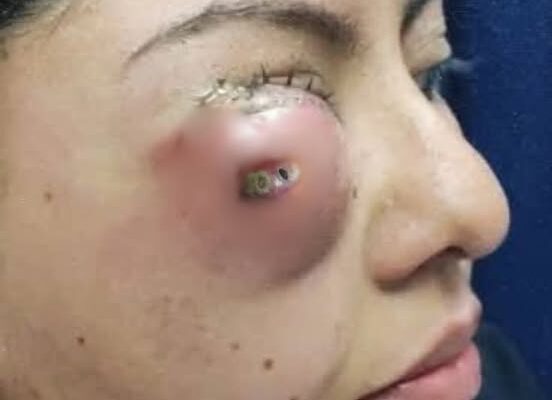What causes a sebaceous cyst?
Sebaceous cysts are formed within the sebaceous gland, which is the gland which produces sebum. These cysts develop when the hair follicles become clogged due to a build up of sebum or keratin. These cysts can also be formed from pimples or as a result of trauma to the sebaceous glands. Individuals with a genetic predisposition such as steatocystoma multiplex, Gardner’s syndrome or Basal Cell Nevus Syndrome are also prone to developing sebaceous cysts.
How do you diagnose a sebaceous cyst?
A diagnosis of a sebaceous cyst can be determined by a physical examination of the nodule by a dermatologist, family physician or other healthcare provider. There are occasions when additional testing is required to make a definitive diagnosis of a cyst, since it can sometimes be mistaken for a different type of skin tumor.
Common tests used to diagnosis a sebaceous cyst include:
- Cat scan – This test is performed to rule out other abnormalities or cancer.
- Ultrasound – This test is performed to establish the contents of the cyst and depth of inflammation.
- Punch biopsy – This test is performed to identify the histology of the cyst.
- Culture and Sensitivity – This exam is performed to determine the type of bacteria responsible for the infection and the best antibiotic to treat the infection.
- Physical Exam: The provider will check for a lump or swelling under the skin. A sebaceous cyst usually feels firm, round, and mobile beneath the skin. It may be located anywhere on the body but is commonly found on the face, neck, or back.
- History: The provider may ask about the symptoms, like when the lump first appeared, if it has grown in size, or if it’s causing pain or discomfort. A sebaceous cyst is often painless unless it becomes infected or inflamed.
- Visual Inspection: The cyst might have a small opening (a pore) in the center, through which the contents may drain if the cyst becomes infected or ruptures.
- Possible Additional Tests: If there’s any doubt about the diagnosis, or if the cyst is large or causing complications, further tests might be recommended. This could include:
- Ultrasound: To help determine the size and structure of the cyst.
- Biopsy: In rare cases, a biopsy may be done to rule out other conditions, especially if the cyst appears unusual.
